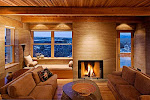Paraphrased from an online discussion:
a Canon 21MP file is fine but the digital process is soul-less......I couldn't disagree more. Understand. I made my living pretty much exclusively with a 4x5 and film for almost 30 years. To me, making images is never soulless unless you have detached yourself from the process and that is about you-not the camera being used or the quality of the architecture. I used to make my AP photography students photograph a small building near the University of New Mexico that was pretty much a stucco box, because sometimes for clients your you have to photograph crappy architecture and make it look good. Some students balked at the project but once they got into it they made the most astonishing images in amazing light. Its all about your attitude-not the camera or the architecture. At 58 years old with 31 years in the business, I am having more fun now than ever. I also continue to use the 4X5 VC pretty much exclusively for my personal work and of course for the beloved HABS projects. I love the "shift" in workflow from what I do everyday.
As per the old Canon T/S lenses. (I will buy the new ones if tests confirm they are better in the corners less with less distortion etc., the rotating tilt is of very little use to me). I work very carefully, which is easy for me having learned my trade on VCs. So, I shopped for the best copies I could find, am careful in the field to not exceed their capabilities and work with the images very carefully in PS to correct the flaws. None of my high profile clients from New Mexico to Chicago, Boston or New York, including magazines or designers have ever complained about the image quality of my work from DSLRs.
What about crop sensor cameras (full frame is the same size as 35 film frame, a "crop" sensor camera has a smaller chip and hence a narrower field of view on a given lens). Now that the full frame sensor bodies are reasonably priced, in combination with T/S lenses, they are clearly the way to go for architecture and interiors. With crop sensors, and especially zoom wide angles, once you get the perspective straightened out (which involves cropping and interpolation), and the barrel distortion straightened out you have compromised allot of the original resolution of the image. I have students who work with crop sensor cameras and zoom lenses for architecture and the final result, though adequate for many purposes, is clearly inferior to a FF with T/S lenses.













No comments:
Post a Comment